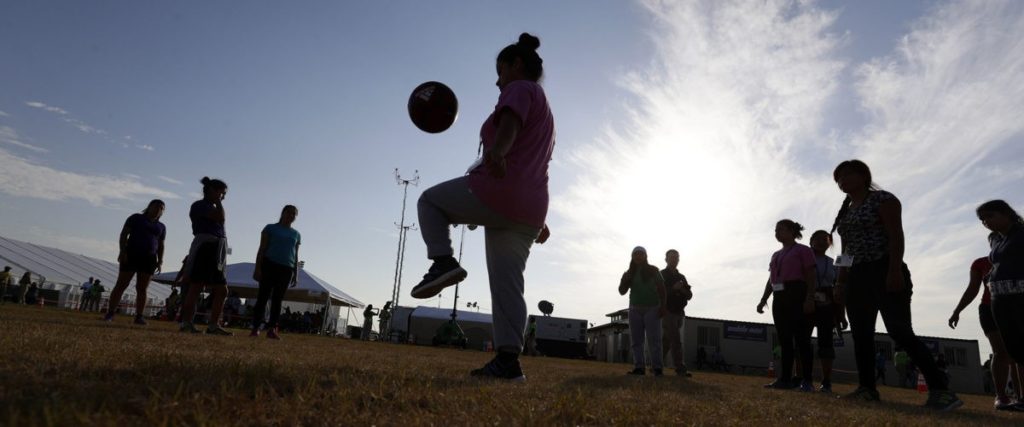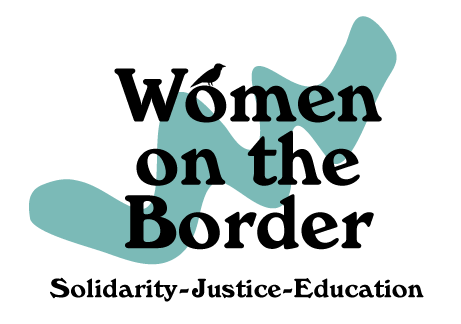
Photo: AP/Eric Gay. July 2019
The detention center in Carrizo Springs, TX reopened in February of 2021 to hold unaccompanied minors crossing the US-Mexico border and surrendering themselves to immigration authorities. Officially designated a “temporary overflow facility,” it continues to hold hundreds of immigrants from Central America who are under the age of 18 and have arrived without an adult. Many have tested positive for Covid at the border and are completing a 10-day quarantine. Others are simply waiting for case workers to contact their family member or other US sponsor and complete the bureaucratic requirements for them to be released.
The center is under the jurisdiction of the Department of Health & Human Services’ Office of Refugee Resettlement and day-to-day operations are managed by San Antonio nonprofit Baptist Child and Family Services. It costs about $775 dollars a day to detain a child at Carrizo Springs. Most are held for several weeks. Some have brothers or sisters in the same facility, although they are usually housed in different areas. The children are permitted to call and talk to their US sponsors twice a week. They go to class, receive all the required child vaccinations, and play soccer in the courtyard.
Compared to the human rights abuses in ICE detention centers in recent years, this is a marked improvement. Nonetheless, Sarah Valdes, Director of Released Children’s Services at RAICES, states that the “biggest threat to any of these children’s safety is that they will be deported by the U.S. government back to the most dangerous places. That’s what DHS and DOJ are at work trying to do. No matter how nice the HHS/ORR facilities are, as long as DHS/DOJ is allowed to charge the children in their care for deportation they are not safe places for children.” (“RAICES Joins Member of Congress and White House Delegation to Carrizo Springs Children’s Detention Center,” 3/24/2021).
RAICES offers Know Your Rights Presentations to all the detainees. They also organize volunteers like me to conduct intake interviews designed to gather basic information about each child: their country of origin, the names and contact information of their parents and their US sponsor, the reason for their travel to the US, and whether they were trafficked, exploited on the journey, or had their rights violated by US immigration. I enter this information into a database so that once the young person is released from detention, RAICES can begin the process of finding a lawyer to take their immigration case.
I log into a Zoom meeting and am placed in one of the numbered rooms. The rooms are both virtual (as in a Zoom “breakout room”) and actual small rooms at the detention center in which a table and chair are visible and a number between one and 10 is printed on a piece of 8 ½” by 11” paper taped to the cinderblock wall next to the door. A teenager or sometimes a younger child is brought in by a guard who indicates to them in a combination of Spanish, English, and pantomime, where they should sit, what to do when they are finished, and where they can find the bathroom if they need it. The child sits down at the table and the guard departs. At this point I turn on my camera and microphone and invite them to remove their mask, then we say hello.
Most of the children do not tell me stories that meet the criteria for either asylum, or trafficking, although many could be described as “abandoned” by at least one parent, something that might qualify them for a Special Immigrant Juvenile visa. The possibilities for claiming the right to stay in the US are narrow and specific. Most of the children tell me they have come either to study or to join a parent who has lived here for a long time. Some say that they plan to work and send money back home. There are a few who are fleeing abuse or death threats from criminal gangs. They really do need protection, but most will not win in immigration court.
For the most part, these young people are fleeing poverty; they are fleeing schools closed by the pandemic; they are fleeing economies ravaged by climate change and corruption. They are running away, or being sent away, from hopelessness and violence. They come like migrants always have, filled with courage and the determination to “get ahead” and to “find a better life.” I hope against hope that they will find it. But without fundamental changes to our immigration system most of them will not get the education or the prosperity they seek. They will not be allowed to realize their dreams or to enrich our society with their energy and talent.
Meanwhile, I smile and offer welcome and tell them a bit about the place they will live once they join their sponsors. I tell them that if they travel there by plane they should sit next to the window and see how amazing it is to be above the clouds. I make them promise me that they will get in touch with RAICES as soon as they get to where they are going, especially the ones who are almost 18. I hope we will be able to give them at least a fighting chance.
I wish them well before turning off my video and sound and notifying the RAICES coordinator that I’m ready for the next one.
